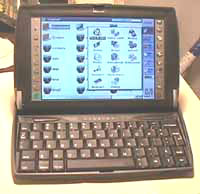Why Psion (EPOC)? After all, this platform in Russia is traditionally not as common as, for example, Palm, although in Europe, for example, the situation is reversed. But things tend to change, but for the sphere of high technologies, this assertion is especially important. EPOC is rapidly gaining popularity in the telecommunications sector due to its compact size, low system resources, easy adaptation to any type of device and reliability - not for nothing that this operating system drew attention to the major manufacturers of mobile communication equipment. PDA Psion has long been known as a reliable, extremely easy to use and economical device, they are always different from the refined design. Throughout the world, users are paying more attention to these devices - not without reason Psion opens new regional offices in different countries. Even in the U.S., where traditionally the stronghold of Palm, there is a significant increase in demand for Psion. A backlog of Palm in Russia can be explained rather frankly weak promotion of the brand PDAs on the market. I am sure this article will help readers learn more about the interesting world of Psion, and possibly even cause a desire to join him. If this happens, then I'm sure you're unlikely to regret about it, believe my experience. One day, opting for the platform, would not want to use something else. The purpose of this article - do not just give an overview of the model number of Psion, but rather an attempt to make some "inside look" at the possibilities offered by handheld computers (hereafter - CCP) from the pioneer of this trend - the British company Psion PLC. We begin with a brief excursion into history. Psion PLC originally conceived creator - David Potter (David Potter) - as a company, a software developer. And indeed, his first steps (starting with the base year - 1980) Psion made in this direction - was developing computer games for the once popular in our country, Sinclair ZX81 (more known as Spectrum), and quite successfully. Having made a name for himself in the computer world and the initial capital of Skopje, the company began to enter other markets, then virtually unknown. It is necessary to pay tribute to the sagacity Potter - he could see then what was obviously not for everybody but still features the then the electronics industry and technology were not allowed to talk about too much of miniaturization. However, many electronics manufacturers, for example, Sharp, have already started production of programmable calculators and even a sort of microcomputers with built-in BASIC interpreters.
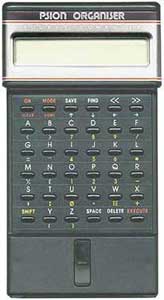 |
Yet the first "real" PDA is launched in 1982, Psion Organizer. From the standpoint of modern man, accustomed to the wonders of technology, this device was extremely primitive: a one-line LCD screen, 2KB of RAM, a processor with a clock frequency of approximately 1 MHz. However, the Organizer has been an important feature: it was not just a calculator, and in some measure a personal information device - it was built simple notebook and a clock. The device also had the opportunity to expand: two slots for special cartridges with additional memory, or even RS-232 port! The device was equipped with 37-key alphanumeric keyboard, there was strong body and a sliding cover that protects the keyboard. Dimensions and weight of the device at that time were also at the level ": 142h78h29, 3 mm, 225 g. At the cartridges supplied with different utilities, including programs for financial and scientific calculations. The device was popular, for it was a large number of application software. This is also one of the important features of the Organizer: for him it was possible to create your own software, which attracted a large number of developers.
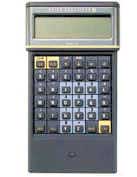 |
In 1984, a model Organizer II, incidentally, is still producing (albeit under the order). Produced modifications to the increased RAM, specialized versions to work as shop terminals, etc. The device is widely used as a data collection terminals in trade and industry (the good, extremely durable and reliable design that helped). Organizer II is still used by many users precisely because of its legendary strength. It is the use of these devices in the industry gave impetus to the emergence of industrial PDAs.
 |
In 1984 he was released on a specialized industrial computer HC. He had a 80C86 processor with a clock speed of 3.84 MHz, 256KB ROM, the screen is 160x80 pixels with backlight. Modifications differ mainly in RAM (128Kb in the base model). Used for expansion slots for drives SSD (Solid State Disk, of solid discs) - "branded wheels" Psion. Also in the HC the prototype operating system, in what has become a sort of bestseller - SIBO (Sixteen-Bit Organizer). However, instead of a graphical interface used DOS-like command line. The file system is compatible with DOS, the ROM has been included language interpreter OPL (Organizer Programming Language), which subsequently created a great piece of software for this platform. Also produces a large number of accessories - docks, special portable printers, scanners, etc. Subsequently, the concept of HC has found a new incarnation of modern industrial terminals WorkAbout.
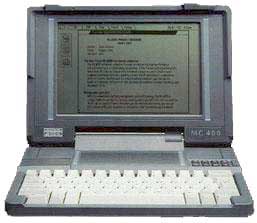 |
But Psion did not think limited handheld devices - and as it turned out, in vain. Somewhere in the early 90's the company attempted to enter the market such as notebook computers (or, as they said, laptops). Published a series of MC: MC200/400/600/WORD. Despite the fact that for the time these devices were mounted technology and design idea (touch pad, graphical user interface, great battery life), a series of MC was the biggest failure Psion - affected unnecessarily overpriced.
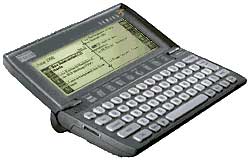 |
But life goes on. Not everyone needs industrial terminals. And Psion draws attention to the needs of ordinary people. In 1991 he produced the first model of the "third" series, subsequently became a bestseller: Series 3 'Classic'. This model was released in 1991 and for several years has defined the look and functionality of computers Psion. The original folding case design, 128 or 256 KB of memory, big enough and comfortable keyboard, a fully graphical user interface (though only controlled from the keyboard), multi-tasking. Was used 80C86-compatible processor NEC V30H with frequency 3.84 MHz. In the ROM was "stitched" nice set of applications - diary, word processor, spreadsheet, simple single-table database, a programming language OPL, reference base in the cities of the world and the world clock, calculator, etc. Software quality of the whole "third series was just incredible - the system was literally licked to a shine. For all the time its existence was not detected in any substantive errors. The operating system used in these PDA, called SIBO (SIxteen Bit Organizer - 16-bit organizer).Good development tools and familiar to most programmers architecture 80h86 did their job - the number of programs for these devices has been growing like a snowball).
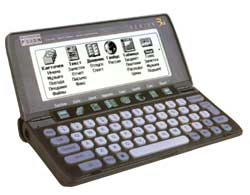 |
In 1993 he released Model Series 3a. From its predecessor, features a large screen size (480h160 points), increased memory (from 256 to 2 Mb in the latest versions), double (7,68 MHz) processor, built-in spell checker and even a card game of "patience." Also been set up only to date hardware Russified model - Series 3aR. It was possible to expand the memory by removable disk SSD. There was a serial port, however, unusual. To connect to a desktop PC requires a special cable.
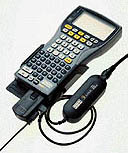 |
The branch also developed industrial terminals. Its final incarnation was WorkAbout - a real workhorse, extremely reliable and robust computer. Due to the special extensions (bar-code scanners, radio modems, etc.) adapts to any production needs, such as inventory control, etc. In Russia, the terminal WorkAbout even "armed with" a unit of the traffic police. Specifically for these devices has been created among the accelerated development of applications - OVAL (Object-based Visual Application Language), is compatible with Visual Basic. In 1996 he released Model Series 3c. Speed serial port (now a "normal" RS-232) was increased from 19200 to 57600, was attended by an infrared port (but again non-standard) lighting. Memory size 1 or 2 MB.
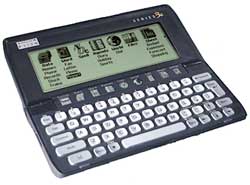 |
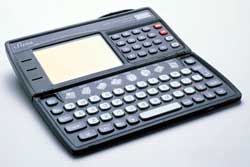 |
In the same 1996 Psion went to another segment of the market handheld devices and presented Siena - a sort of "lite" version of the Series 3 for those who need no PDA, but rather a powerful organizer. The screen has been reduced by half, the size and weight of the device have also been considerably reduced - it can be easily put in your shirt pocket. Suite of applications has not changed. Unfortunately, the inherent Psion innovative approach to design housing for all their devices (and each model features some kind of "pearl" in the design) played a better role: Siena was not too strong - especially frequent were broken hinge housing. And the price was not, alas, a little (unfortunately, this kind of "fad" Psion - the price of their devices are kept high, but most likely due to the fact that primary production is placed in England, where the cost of its very large).
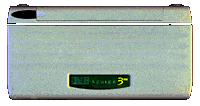 |
A year later (in 1997), the final accord, "the third series was released model Series 3mx - with a clock speed of 27,684 MHz and a serial port speed 115200. It turned out that the release of this model coincided with the transition Psion to an entirely new architecture and with the release of the first model in the series - Series 5, Series 3mx why sales were low. At this "Third Series" has ceased development and is currently almost no support Psion. However, these PDAs created a huge number of applications of different properties (alas, most of them do not Russified).But stop our historical digression for a moment and try to understand what determined the success of SIBO (during the existence of a "third series has sold several million units). First, as noted earlier, this is extremely attractive design - any device from Psion nice pick up. Secondly, it is perfectly designed and implemented an operating system, in which all left to chance. Third, a great set of applications on almost all occasions:
- Word text editor with features of text formatting (fonts, spacing, spelling, etc.);
- Spreadsheet Sheet - a fully featured table, not much inferior to their desktop counterparts (though not multipage);
- simple single-table database Data;
- amazing diary Agenda - still considered the best among all similar programs;
- alarm clock;
- base, "World Time" World - information about the large number of countries and cities in the world with telephone codes, offset to UTC, etc.;
- programming language OPL - a powerful BASIC-like language, which produced most of the applications for SIBO;
- powerful calculator Calc;
- Jotter pad for taking notes;
- digital audio recording software Record.
Add to this the ability to install any application (on the internal drive or memory card), a good selection of accessories - modems, memory cards, etc. - And we get a very convenient and powerful tool for working away from your PC. Great battery life (here Psion is still an absolute record-holder) can not worry about finding outlets for a very long time. Embedded software enables you to work with documents, and the results of these works can then pass on the PC, transforming the passing of a familiar "desktop" format, for example, Microsoft Office. And the exceptional vitality of the CPC made it possible to use them in any situation without fear for the safety of data and the device itself. But as time passed, there were new technologies, and it became clear that the platform of SIBO has reached the highest point in its development - the possibilities of the hardware platform 80h86 been exhausted, and 16-bit architecture imposed their own restrictions, such as the maximum volume of the document. The question arose about the transition to 32-bit applications, and it was clear that the new system will have to create from scratch. As the hardware platform has been selected ARM, today the best ratio of performance / power consumption. Developing a new operating system (known as EPOC, which in English sounds like "epoch") was engaged in division Psion Software. In 1997 he created the first product based on EPOC - Psion Series 5.
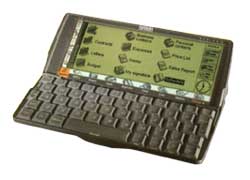 |
It was a real revolution in the world of PDAs. Convenient and relatively large keyboard, good screen 640x240 pixels, 32-bit ARM processor 7100, 4/8Mb memory slot for Compact-flash, which became by the time the industry standard, IRDA-compliant infrared port, serial port RS-232 touchscreen screen and the new OS with an excellent set of firmware, the original design with the "moving out" keyboard - all contributed to the fact that demand for the Series 5 was very high during 1997-1998. True, very quickly became clear that the design (or rather type) devices are very fragile (most often broke the loop connecting the halves of the device), is pleasant to the touch rubber coating has a strong tendency peel, giving the device obsharpanny view, the screen is quite easy to break, and stylus ( Pen-Pointer) has a habit of getting stuck because of the distortions case. Subsequently, the situation has improved - the body became stronger, the coating does not peel so much. Still, "the first attempt" was a bit lumpy. Nevertheless, the new system had good success. And thanks to the new OS from the start conceived as easily portable and versatile system for personal information devices of various types, it has become seriously interested luminaries telecommunications market - Nokia, Ericsson.All this has led to what is in the same 1997-based Psion Software has created a new public company Symbian - the brainchild of Psion, Nokia, Ericsson and Motorola, whose main objective was the development and licensing EPOC manufacturers of telecommunications equipment. Later Symbian joined Matsushita (better known under the brand name Panasonic), IBM, Sybase. Plans for Symbian far-reaching, but rest on your laurels is early - the competitors (in particular the notorious Microsoft) are not asleep. The market of mobile technology is so appealing and promises such profits, that fight for this tidbit turned serious. In addition to Psion, EPOC-based devices also announced Ericsson and Motorola. In particular, this year, Ericsson has launched R380s - a hybrid cell phone and organizer, a so-called smartphone. The device can operate as an ordinary cell phone and a PDA - with its help, for example, can read email, browse WAP-page, etc. But back to the Psion. After the release of Series 5 has come a standstill. While major competitors Psion released more and more new models, Psion itself in no hurry to please us with new products. And only after two (!), In 1999, finally began to appear the rumors about the new model. And here in the summer of 1999, the public was presented model Series 5mx. Despite the fact that superficially it differed only in color shell filling has undergone very significant changes.
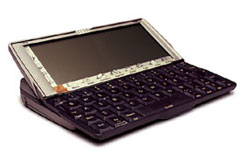 |
Series 5mx equipped ARM710T processor with a clock frequency of 36.864 MHz (twice more than the Series 5), significantly improved screen, 16MB of memory and a new version of the EPOC (Release 5). The last item is perhaps the most important novelty: for elapsed since the previous version (EPOC Release 3), the system has undergone substantial revision. Highly optimized code that is added (and integrated into the operating system) tools to work with e-mail, faxes, cell phones, support for WAP, appeared a full Web-browser and a virtual Java-machine - in other words, the system has reached a qualitatively new level. Embedded applications have also undergone some changes, for ease of synchronization with desktop PC, a special base Contacts. Performance of the new system also significantly improved (compared with the previous version is 2-4 times only by optimizing the code). In combination with a faster processor overall performance CCP increased by 3-5 times. For the German market was released model Psion 5mxPRO, in which there is no ROM, and the operating system is loaded into memory cards Compact-flash, which allows to upgrade the system. In the same year Ericsson has released a MC-218, is essentially a clone of the Series 5mx with a different color casing and slightly augmented set of applications - there was a special application for adjustment of cell phones, software for creating and sending e-cards and WAP-browser. The kit also supplied infrared modem for cell phones Ericsson. Unfortunately, Ericsson is not very actively promoting this product, so its sales were not as great as in Series 5mx. The new model was a huge success. In the same 1999 Psion introduced two new items:
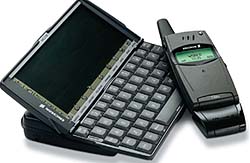 |
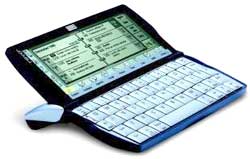 |
REVO - tiny and very nice computer for speed equivalent to the Series 5mx, but with less memory (8MB) and no expansion slots. Connecting to a PC - via a docking station rather than through a special cable, like the Series 5.Set of applications the same, plus there were special application to work with cell phones. In 2000, released an updated version of REVO Plus with 16MB memory.
Series 7 - the computer can not be called a pocket, but rather a sub-notebook. Color screen 640x480 pixels, 133-MHz processor StrongARM, 16MB memory (expandable to 32MB), slots Compact-flash and PC-Card (PCMCIA). Was also released production version - netBook, feature twice the amount of memory, a faster 190-MHz processor and a lack of memory (as in Series 5mxPRO), and 4Mbit / s infrared port. What we offer Psion computers today? As usual, this full set of modern office applications:
- powerful text editor Word with great possibilities of text formatting, styles, templates, spell checker, the ability to insert pictures, tables and other objects;
- Spreadsheet Sheet, however, unfortunately, still not Multipage;
- program digital recording Record (Series 5/5mx can also be used as a voice recorder, without revealing - for the housing there is a special button);
- graphics editor Sketch, roughly similar in features Microsoft Paint - there is always the possibility of something quickly to sketch or write (you can, for example, to insert your signature in a document Word);
- diary Agenda - the best for today; Agenda will not give sleep in the morning, remind you of birthdays girlfriend or wedding day, let you know what kind of things planned for today, will help to distribute the time - in general, indispensable thing for those who do not much trust their own memory ;
- World Clock Time - information on major cities and countries around the world, time zones, the distance between cities, sunsets and sunrises, the location of settlements and much more;
- Notepad Jotter - take notes as in a regular paper notebook, with the ability to quickly search and editing;
- Database Data - to store a wealth of information. Up to 256 fields of any type (text / number / date, etc.), the ability to insert graphics into text fields, any field names. As an option - Address Book;
- Terminal Comms - a simple terminal program that supports the Terminal ANSI, VT-42 and VT-100 (for example, for remote administration), exchange files with other computers on the old X-modem protocols and Y-modem;
- powerful calculator Calc;
- Email Client Email - access to email, SMS and fax;
- Base Contacts - to store information about all the friends and acquaintances with the ability to exchange data with popular desktop applications like Microsoft Outlook;
- programming language OPL, although not as powerful as in SIBO, but enough to write simple programs. Translator and editor built into the PDA, so application development can be carried out on the device itself;
PDA Psion, being fully self-contained devices that perfectly communicate with the outside world by connecting to a desktop PC via a serial or infrared port for information backup, synchronize with desktop applications, organizational, exchanging documents with automatic data conversion on the fly. " For me personally, Psion has long been an indispensable and reliable helper, always helping out in difficult times, when an urgent need to find a phone a friend, read your e-mail away from your desktop computer, do not miss an important event or meeting, and even sort out the city - a beautiful card company PalmGIS Kiberso not only help to find the street or even a house, but also tells you how to get to the right place, show what metro station is nearby, etc. Can hardly imagine how I could do without all this - the amount of paper that would carry with them, it is difficult to imagine. Discussion of the article in the conference Sources, Materials:
Mobile Computing
The authors, translation:
Vladislav Voronin














